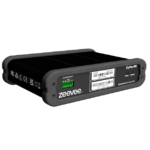Live-action IMAX and IMAX 3D cameras have been instrumental in the production of all of IMAX’s documentaries, more recently being put to use by Hollywood filmmakers to shoot select action sequences, including standout scenes in Christopher Nolan’s The Dark Knight, Francis Lawrence’s The Hunger Games: Catching Fire, Brad Bird’s Mission: Impossible – Ghost Protocol and in Michael Bay’s Transformers: Revenge of the Fallen.
IMAX used its social media platforms last week to announce that Adele’s new single, Hello, is the first ever music video to be filmed using IMAX cameras.
Directed by 26-year-old Canadian filmmaker, Xavier Dolan, the video uses the same cameras that have been featured on films such as Interstellar, The Dark Knight and the upcoming blockbuster, Star Wars: The Force Awakens. Despite only being released on October 23rd, at the time of writing the video has already racked up over 311 million views on YouTube.
“It’s not a ground-breaking video in terms of effects and dance moves, but it’s my best video and I’m so proud of it,” said Adele, speaking to Apple’s Beats1 radio station.
Watch Adele’s music video for Hello:
So what’s the difference between regular cameras and IMAX cameras? According to IMAX, their cameras are “the highest-resolution cameras in the world.” The resolution and aspect ratio of IMAX sequences are optimized for the IMAX screen, allowing the picture to expand to fill the entire screen and provide an even more immersive experience.
Among other differences, the IMAX camera uses 70mm film—twice as wide as what’s used in ordinary cameras—and special, custom lenses to capture a unique IMAX image.
“Seventy-millimetre film yields an extraordinary negative, brilliantly sharp, with a wider, more subtle color ‘gamut’ and the richness many directors say only comes from film,” says IMAX.
One main drawback seems to centre on the large size and weight of IMAX cameras (and also the noise they produce). In fact, an IMAX camera weighs 109kg (240 pounds), requiring special supports and rigging to move it around. A typical 35-mm movie camera, by comparison, weighs only 18kg (40 pounds).
However IMAX states that it will be expanding its repertoire of capturing tools by perfecting a next-generation 2D and 3D digital camera that it promises will be “small and nimble enough to go anywhere.” It will also be hand-held and will be capable of taking longer shots, meaning that directors should be able to work without interruptions because there will be no film to change. The size of the film can also be problematic, meaning that the camera can hold only a three-minute spool, which takes 20 minutes to reload.
Photos: Feel the IMAX Effects of Hello, Interstellar & The Hunger Games
Speaking to Mashable, The Hunger Games: Catching Fire director Francis Lawrence admitted that the shoot was technically challenging. “The noise of the camera invades the scene—it sounds like an old projector and there’s lots of clicking. The actors had to perform normally and then after the shoot, we brought them back in to do the dialogue again.”
The incredible detail available with a film size this large can produce its own set of issues for directors and cinematographers, who must go the extra mile to ensure that every shot is perfect. After all, the audience will see every flaw when presented in such detail.
“Because you’re much closer to the screen the picture has to be that much sharper—even while it’s also bigger than life,” says IMAX. “And that calls for enhanced content that plays through a custom digital projection system—or actually a set of two—that produces a picture that’s not just sharper from edge to edge but also brighter. And that’s important because your eyes perceive a brighter picture—and a sharper one as well.”
Film Formats
The IMAX cinema process increases the image resolution by using a large-frame film; a frame of 35mm film produces approximately six thousand lines (6K) of horizontal resolution, but an IMAX-format film frame produces approximately 18 thousand lines (a whopping 18K) of horizontal resolution.
To achieve such increased image resolution, 65mm film stock passes horizontally through the IMAX movie camera, 15 perforations at a time, which at 24 frames per second means the film moves through the camera at 102.7m per minute.
















